
Image 020709-01-01
Very basic mark used around 1835.
The first factory in the town of Waldenburg was founded by C.S. Rausch in 1820, and even if the business only had a single kiln it was still fairly successful. Attracted by the local possibilities a second factory was opened by the businessman Traugott Hayn in 1829. These two facilities had quite an interesting fate. A decorator from Thuringia at the Rausch facility changed to Hayn and eventually took over the business in 1831.
This former employee was of course no other than Carl Franz Krister, who in 1833 also bought the company from Rausch for an amount of 15,500 Taler. It can only be speculated on how Krister actually was able to pay for all this but it appears that before he even started to work for Rausch he already owned a kaolin deposit near the city of Meißen in Saxony which he then used as source for raw material; the required quartz was delivered from a quarry in Schreiberhau (today Szklarska Poręba).
Straight from the start Krister tried to catch customers by imitating the item style and base mark of the Königliche Porzellan-Manufaktur (KPM) in Berlin. Being very cautious, he decided to use a simple vertical bar instead of a sceptre. When KPM Berlin shortly afterwards added the initials "KPM" to their mark, Krister also added these letters (for Krister Porzellan Manufaktur) and successfully defended them even after the KPM Berlin tried to stop him via court decision. From the end of 1844 onwards, the KPM Berlin changed the strategy and introduced the imperial eagle with sceptre and orb over the initials 'KPM'. Krister followed up with an own version of the mark, omitting the scepter and orb.
But Krister would not have been successful by only relying on copying the famous 'KPM' products and marks. The quality of his products was exceptionally good, and he soon had lots of wealthy customers. Export to customers all across Europe and North America therefore started around 1849. Over time, his business became quite well known and further recognition was achieved through the medals his products earned at the exhibitiona in Wroclaw (1852) and Paris (1867).
Sadly, Carl Krister died the same year at the age of 65; business fell to the Haenschke heirs. It should be noted that at the time he died, the business had developed into one of the largest firms led by a single person next to the factory of Carl Tielsch in Altwasser. Anyway, the Haenschke family further improved the factory that employed 800 workers in 1913 and it remained in their hands until they decided to change it into a joint stock company in the year 1920.
In 1921 the company was one of the few manufacturers which produced replacement currency in the form of porcelain coins as the German Mint was not able to produce enough money to follow the very high inflation rates. Proceedings were based on a special law that allowed a few supervised companies to produce so-called Notgeld. The same year also saw the Rosenthal group achieve majority holding, but the traditional name was kept until 1945 when Soviet troops occupied Waldenburg.
As soon as the war ended, it was clear that the area would in future belong to Polish territory and all German citizens with exception of the skilled workers from the factory had to leave the area; the remaining workers were forced to stay until they had re-educated the Polish immigrants. The factory itself was nationalized and renamed to Porcelana Stolowa Krzysztof in 1952.
To compensate the loss of production capacity, the Rosenthal group during 1952/53 built a replacement facility in the town of Landstuhl (Rhineland-Palatinate, Germany) which operated under the name of Krister Porzellan-Manufaktur AG and continued to use slightly altered marks (see there). During 1965, the firm moved to Marktredwitz in Bavaria. The name of the great Silesian enterprise was discontinued in 1971 due to 'organizational reasons' (as they called it). In the year 2004, Rosenthal finally dropped the Krister trademark registration.
The Wawel mark was introduced 1953 and was - in a modernized version - still used years later. The factory itself soon advanced to the most vital production facility in Poland. It constantly expanded and was modernized on a regular basis, resulting in a first class factory with a world wide reputation. In 1994 it was decided to slowly re-privatize the business; after initiating the process in May 1995, the factory started to issue employee shares.
This intermediate period ended successfully in September 1999, but the factory still operated under state supervision for the next few years. It became one of the largest companies in Poland, covering the whole range of items from cheap stapleware through to high-end tableware.
Fully re-privatized, the company was renamed accordingly in 2010. Their website still held announcements for 2016 but turned out to be dead (no graphics/dead links) in December 2016. It was a strong indicator of what was happening; the factory finally closed in 2023.
Most names added to the basic mark types represent the series name; examples include Friederike, Prinzess, Royal Ivory and Rubens.
Next to the marks shown the Krister company also owned various registered trademarks. "Obelisk" was registered at the RWZR under №·60·161 on May 11th 1903 and "Supradur" was registered at the RWZR under №·465·008 on April 13th 1934; in both cases there is no indication on how long these were used or on what kind of products they were applied.
The Krister factory also used so-called "secondary marks", markings which did not state the manufacturer (for various reasons). One of these marks is a crowned "Venus China" (a.k.a. "Venus China Silesia"), which is sometimes seen accompanied by "Bayern" or "Bayern Decor", a statement towards the used decoration.
One mark still missing here is a mark type similar to that shown as Image 1-02; it includes a small "China" placed above the vertical line. And yes, I also omitted various Nazi-period marks. Most of those are fake anyway, so I won't bother to show them or explain how one can find out if they are genuine or not.
A few items produced between 1904 and 1927 also carry a stamped "Granuteco" addition. The same name can be found on items made by Zeh, Scherzer & Co. (produced between 1880 and 1882) as well as products made between 1898 and 1918 by O.&E. Gutherz from Altrohlau, Silesia. Sets with this addition were used as premiums by the Grand Union Tea Company (Granuteco) from New York.

Image 020709-01-01
Very basic mark used around 1835.
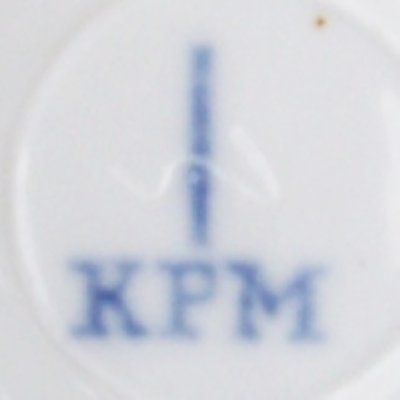
Image 020709-01-02
Used between 1840 and 1895, registered at the Königliches Amtsgericht Waldenburg under №·29 on October 26th 1885.
(Picture by Jeanette Pantin)
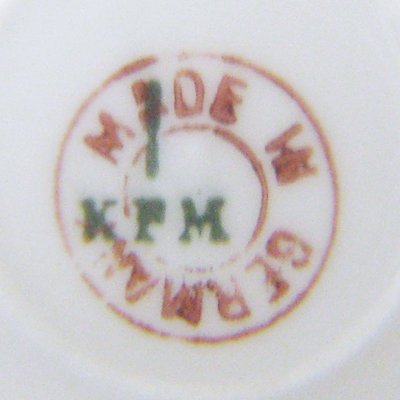
Image 020709-01-03
Used between 1882 and 1895, green version with additional "Made in Germany" mark.
(Picture by James Madden)
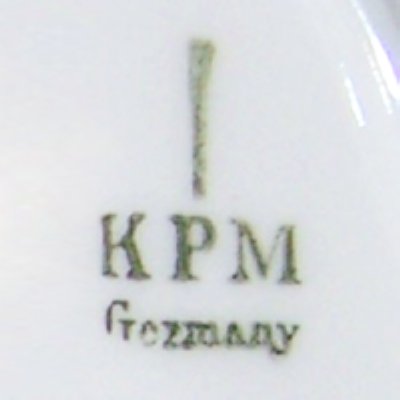
Image 020709-01-04
Used between 1882 and 1895, green version with included "Germany".
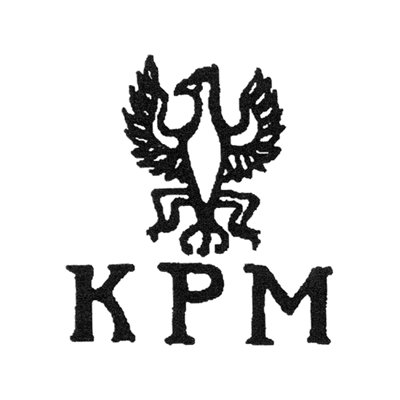
Image 020709-01-05
Used between 1845 and 1870. This type is often very blurred, presumably on purpose, making it hard to hold apart KPM Berlin and Krister marks.
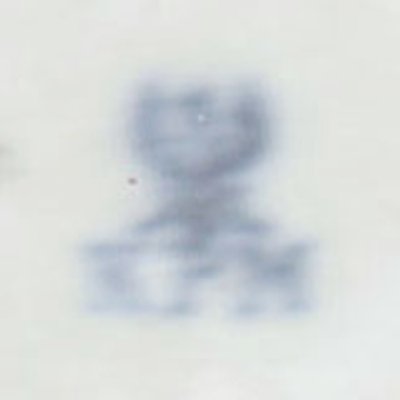
Image 020709-01-06
Used between 1845 and 1870. Example of a typical blurred marking.
(Picture by Robert Trenkler)
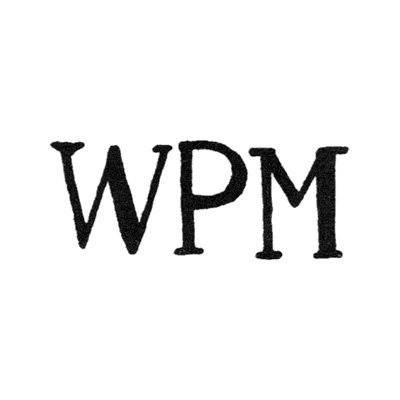
Image 020709-01-07
Used around 1850 in blue underglaze, simply the initials "WPM" for Waldenburger Porzellan Manufaktur.
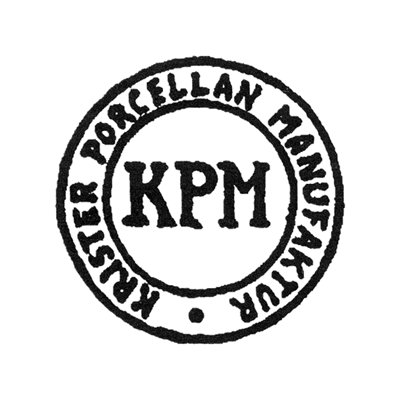
Image 020709-01-08
Round 'donut' shape mark used between 1860 and 1895.
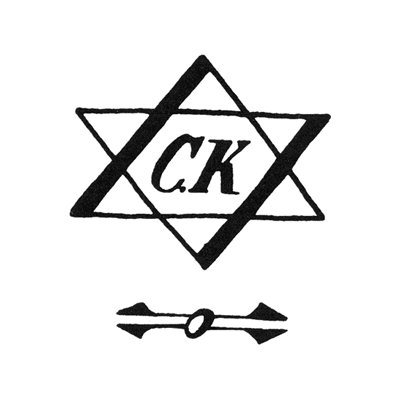
Image 020709-01-09
Used between 1885 and 1905, registered at the Königliches Amtsgericht Waldenburg under №·30 on October 26th 1885.
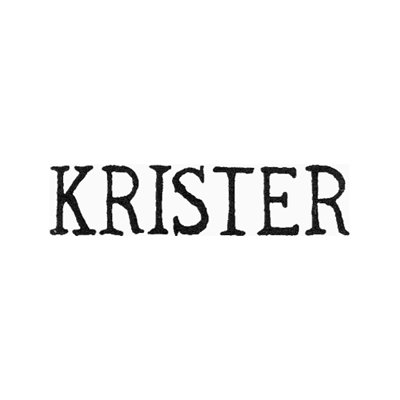
Image 020709-01-10
Used between 1896 and 1905 and from 1922 onwards, this mark was registered in 1896, deleted in 1905 and re-registered in 1922.
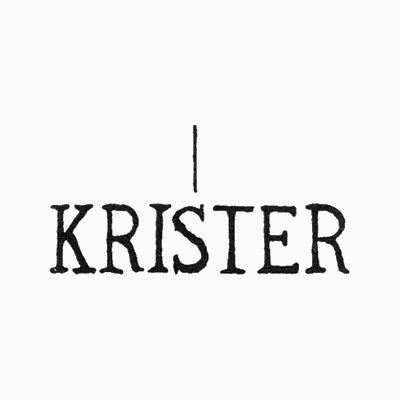
Image 020709-01-11
Used between 1897 and 1905.
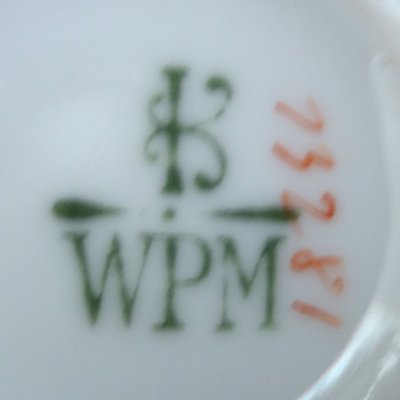
Image 020709-01-12
Used between 1897 and 1905, capital "K" above "WPM" for Krister, Waldenburger Porzellan-Manufaktur.
(Picture by Esther Phillips)
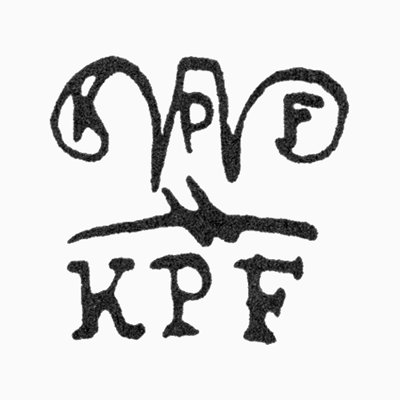
Image 020709-01-13
Used between 1897 and 1905, registered at the RWZR under №·21·974 on February 5th 1897.
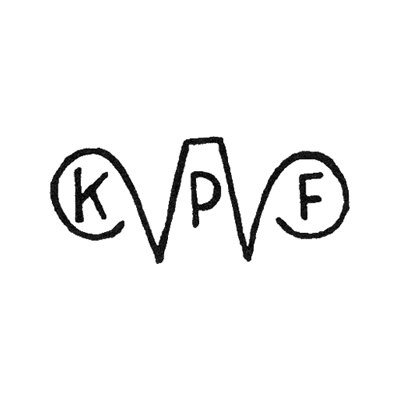
Image 020709-01-14
Used between 1902 and 1905, "KPF" for Krister Porzellan-Fabrik in a stylized letter "W" for Waldenburg.
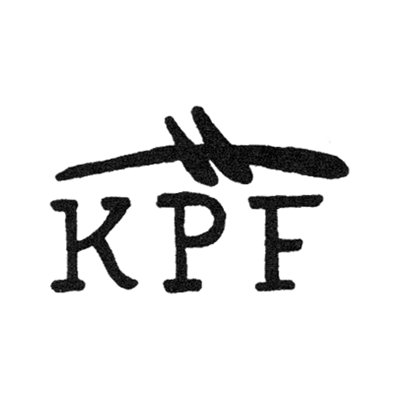
Image 020709-01-15
Used between 1903 and 1905, this version also reads "KPF" for Krister Porzellan-Fabrik.
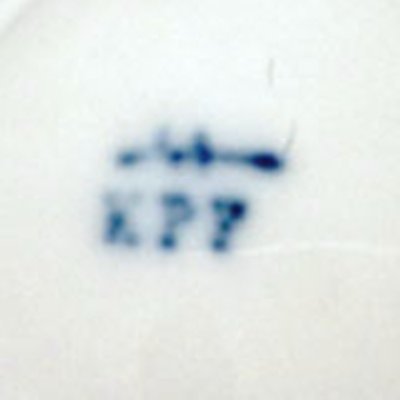
Image 020709-01-16
Used between 1903 and 1905, nice example of the "KPF" mark.
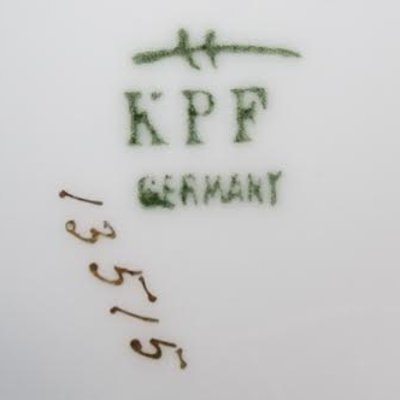
Image 020709-01-17
Used between 1903 and 1905, here a version including "Germany".
(Picture by Edith Schumann)
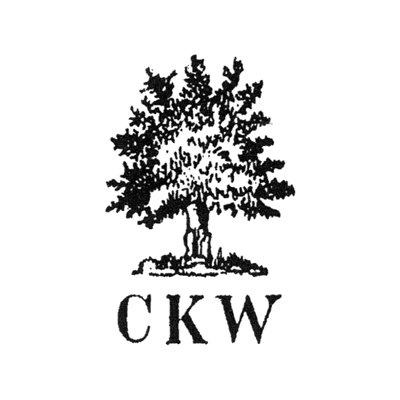
Image 020709-01-18
Used between 1903 and 1910, the "CKW" stands for Carl Krister, Waldenburg.
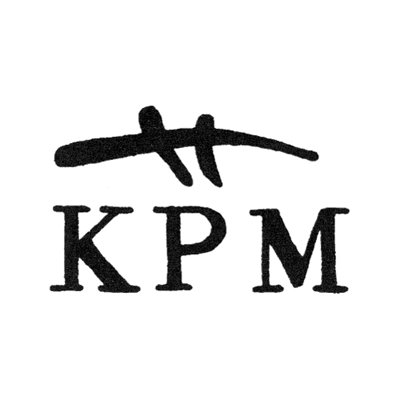
Image 020709-01/02-01
Used between 1904 and 1927, this time with "KPM" for Krister Porzellan-Manufaktur, also found with "Germany" addition.
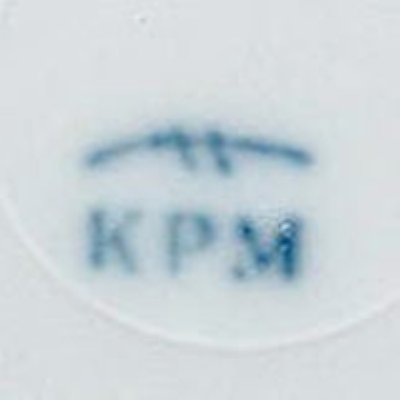
Image 020709-01/02-02
Used between 1904 and 1927, blue version, also found with "Germany".
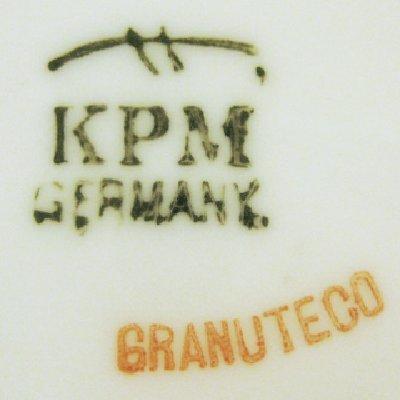
Image 020709-01/02-03
Same as before, this time with the "Granuteco" addition (see Comment(s) section above).
(Picture by Ronald McCutchan)
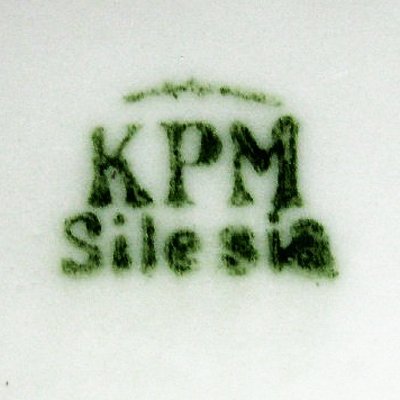
Image 020709-01/02-04
Also used between 1904 and 1927, same as before over "Silesia".
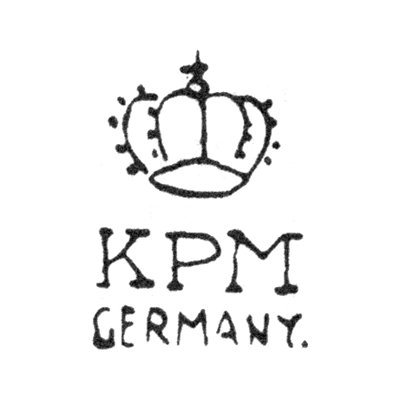
Image 020709-01/02-06
Used between 1905 and 1920, the first version with a bulbous crown. Used with or without "Germany", but no other additions.
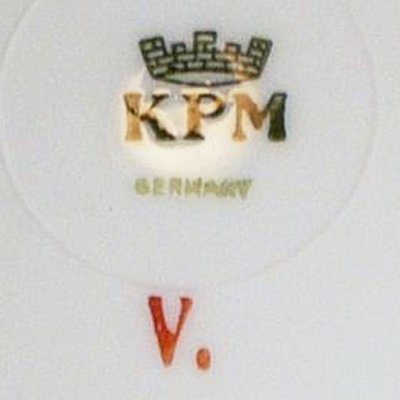
Image 020709-02-01
Used between 1925 and 1945, a brick crown above "KPM". An additional "Germany" was also used sometimes.
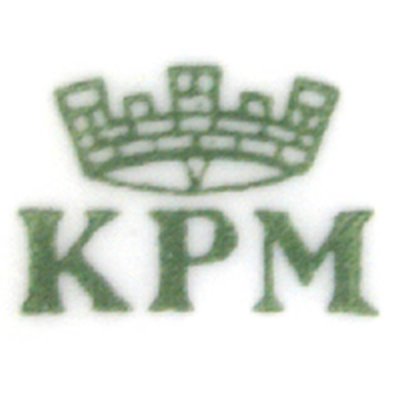
Image 020709-02-02
Used between 1925 and 1945. Note the small "v" inside the crown, others have an "I", "W", or a "P".
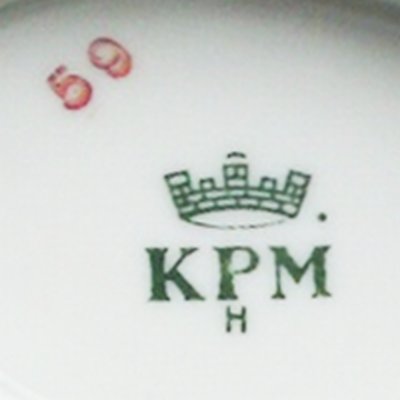
Image 020709-02-03
Used between 1925 and 1945. Sometimes the crown is empty and the letter (here a "H") was added elsewhere.
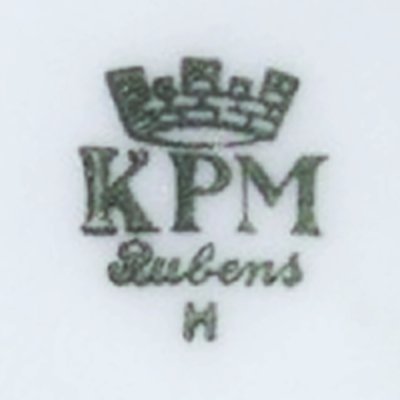
Image 020709-02-04
Used between 1925 and 1945. Various examples also include the series name (here "Rubens").
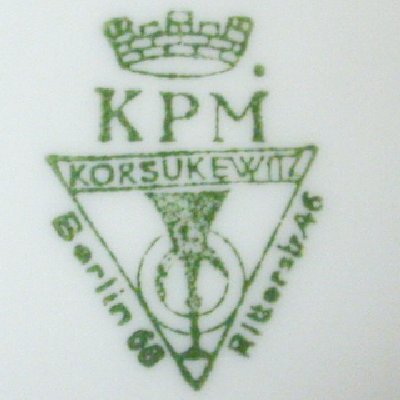
Image 020709-02-05
Used between 1925 and 1945, here with "Korsukewitz" addition (a social institution, feeding the poor).
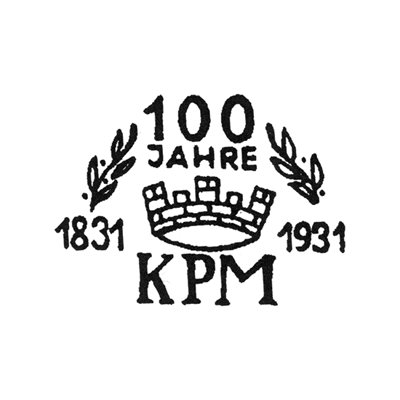
Image 020709-02-06
100 years anniversary mark which was used from 1931 until 1933 only.
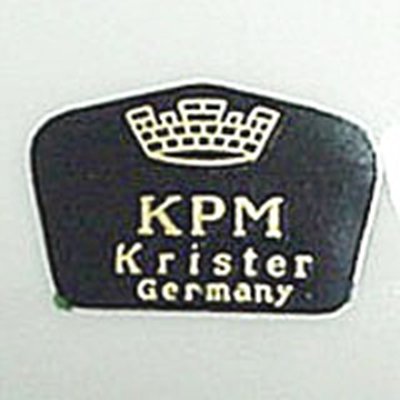
Image 020709-02-07
Used around 1934, on items with special decorations.
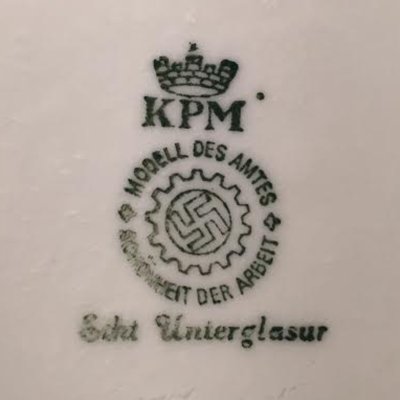
Image 020709-02-08
Used between 1935 and 1939, version with MdASdA and "Echt Unterglasur" additions.
(Picture by David Via)
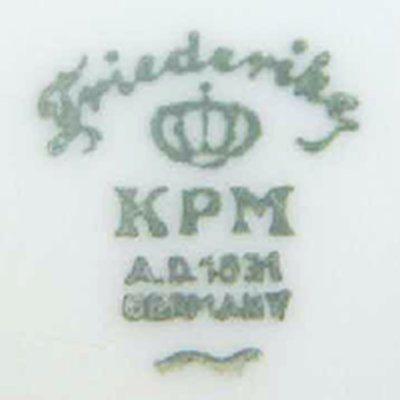
Image 020709-02-09
Used between 1934 and 1945, on "Friederike" series. Note the "A.D.1831" showing the founding date not present in earlier versions.
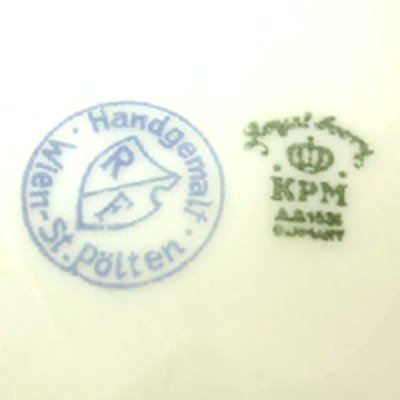
Image 020709-02-10
Mark used between 1934 and 1945, on "Royal Ivory" series. Here with an additional mark applied by a decoration studio from Austria.
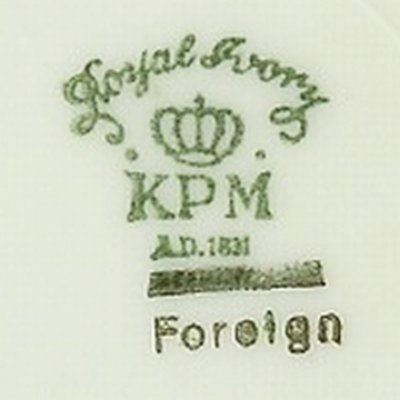
Image 020709-02-11
Used around 1937-1938, blacked-out "Germnay" substituted by a "Foreign" addition.
(Picture by Roberta Rodgers)
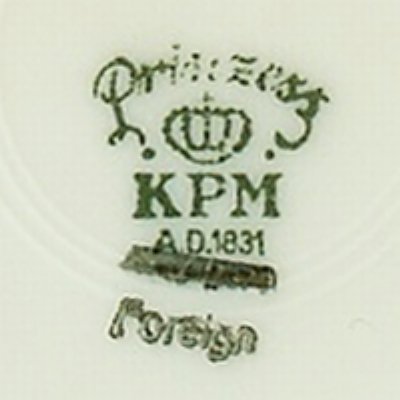
Image 020709-02-12
Used around 1937-1938, also with "Foreign". This time on an item of the "Prinzess" series.
(Picture by Roberta Rodgers)
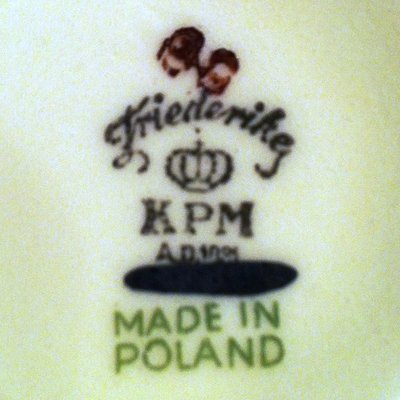
Image 020709-02-13
Used shortly after May 1945, note that "Germany" is blacked out and replaced by "Made in Poland".
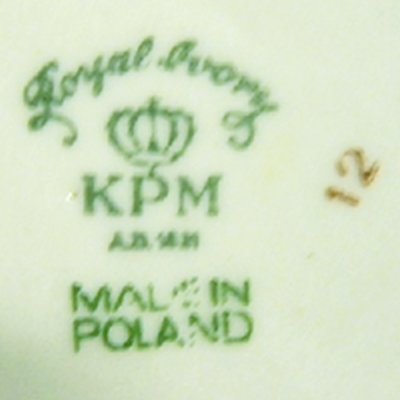
Image 020709-02-14
Used between May 1945 and 1952, bulbous crown mark with "Made in Poland".
(Picture by James Benson)
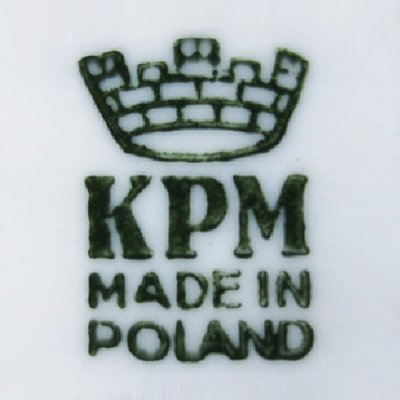
Image 020709-02-15
Used between May 1945 and 1952, brick crown mark, note the "Made in Poland".
(Picture by Henry Kos)
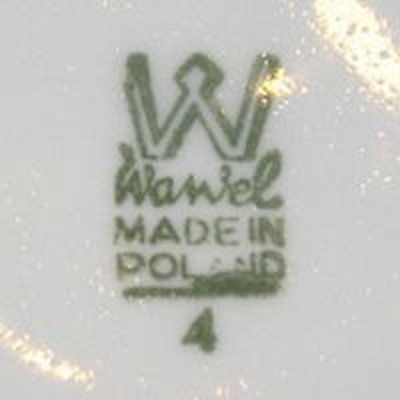
Image 020709-03-01
Used from 1952 onwards, first "Wawel" mark type.
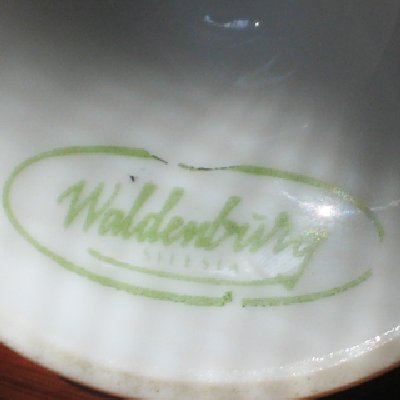
Image 020709-03-02
Used some time after 1952, "Waldenburg" above a much smaller "Silesia".
(Picture by Henry Kos)
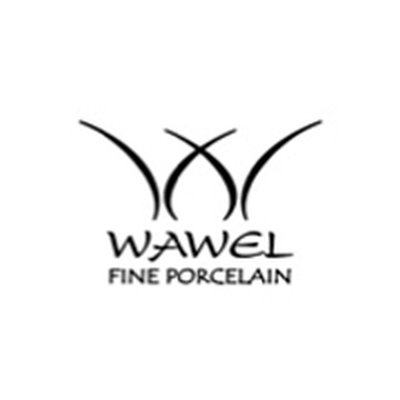
Image 020709-04-01
The "Wawel" company logo 2008.
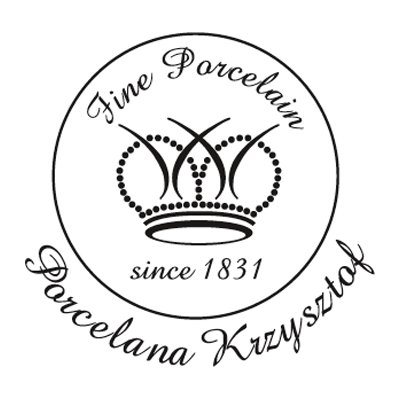
Image 020709-04-02
The "Wawel" logo introduced 2010.
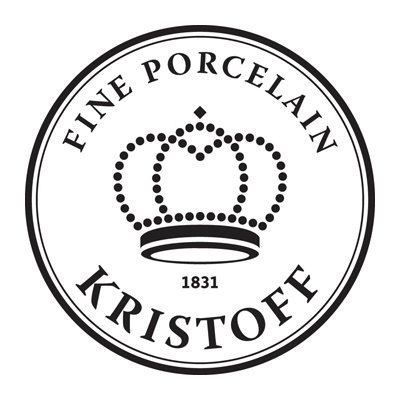
Image 020709-05-01
The "Wawel" logo used from 2011 onwards.
© 2004-2025 C.S.Marshall, all rights reserved